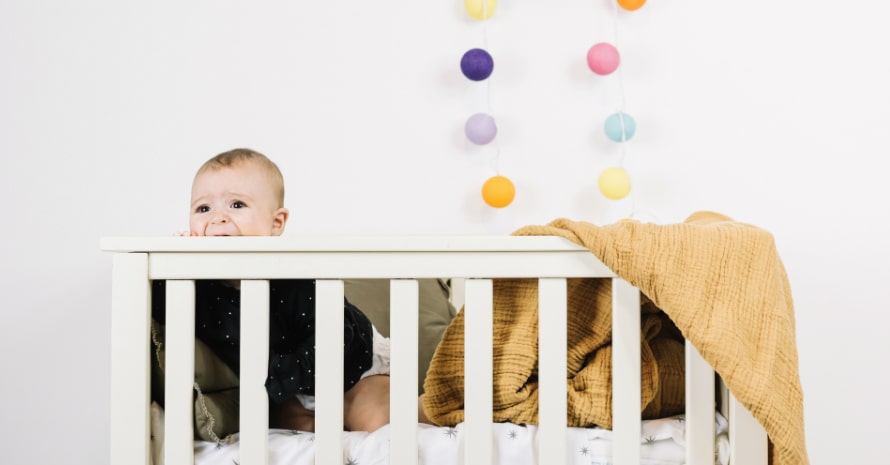
The first few days of motherhood are often a blur of feeding, burping sessions, night waking, and colicky cries. If you are lucky, the baby will sleep well in his crib right from the start. You might even have to wake him up to feed every few hours. Most mothers are not that lucky. The good news is, I have a solution for mothers whose babies refuse to sleep in their cribs.
Having been in education for 7 years, I have figured out what works for most kids. Whereas my job as a kindergarten teacher is mostly about making fun memories with your little ones, it is also about understanding their needs. From what they need to get ready for kindergarten to the best toys for them to play with and how to get them to lead an organic lifestyle – I have tips and tricks for it all.
Today, I will focus on the baby’s ability to sleep in their crib. As a mom of a 2-year-old girl, I have had my fair share of sleep struggles. Thankfully, I have been victorious over most of these struggles. So, if you are just waking up from another restless night of trying to get a baby to sleep without you, here is what you need to know.
Four Types of Baby Cribs – Which One is the Best for Your Baby?
The most common question that new mothers ask when preparing for their baby’s arrival is, “when should my baby start sleeping in the crib?” The answer to this question depends on your particular living situation (size of your rooms, whether the baby has a nurser, etc.). However, it is recommended to transition your baby from the bassinet to the crib as early as 3 months and no later than 6 months.
Newborns sleep better in snug and cozy places. Most cribs might be too big and not exactly snug; this is why you should start off with a bassinet. However, by 3 months, the bassinet might become a tight fit. If your little one becomes much heavier and starts to roll over or sit up, it is definitely time to move them to their crib. So, let’s look at these four types of cribs.
back to menu ↑Standard Cribs
These items are usually rectangular and can be used until a baby is 2 years old. The levels are adjustable so that when a baby learns how to stand, they will not fall out. This is the most common crib type.
back to menu ↑Convertible Cribs
They are usually referred to as lifetime cribs because they can be converted from a crib to a toddler bed and finally a complete bed when your child is old enough. Although this type of crib is more expensive, it is well worth the price.
back to menu ↑Round Cribs
Do you have a room with limited space? If so, round cribs are perfect for you. They give your child plenty of space to sleep in a while taking up very little space in your room. The downside is that they cannot be converted into toddler beds.
back to menu ↑Canopy Cribs
These cribs have an extra fixing; a cute canopy on top that gives your kid a cozy sleeping environment. The downside to these is that once your baby learns how to climb out of the crib, they might hang on the canopy and fall.
back to menu ↑6 Steps to Get Your Baby to Sleep Without You

I should start by clarifying that I have nothing against co-sleeping or bed-sharing. It is a great way to bond with your baby. It also gives you peace of mind, knowing a baby is safe right next to you. However, this guide is for mothers who prefer to have their babies sleep on their own in the baby cradle, whether in the same room or in a separate nursery.
You might want your kiddo to sleep on their own due to safety concerns. Bed-sharing is known to increase the risks of Sudden Infant Deaths (SIDS), especially when the parents are so exhausted that they sleep deeply. Perhaps, you are motivated to take a baby to their crib for them to sleep longer without waking up to feed. Whatever your reason is, here is everything you need to know about transitioning your little one to their crib.
back to menu ↑? Step 1: Make Sure That Your Baby Is Old Enough to Sleep in a Crib
Cribs might be too spacious for a newborn to sleep in. As I have already pointed out, newborns love a snug sleeping area. If your child is less than three months old, you should opt for a bassinet. This will keep them cozy. The bassinet can stand right next to your bed for convenience each time you wake up to breastfeed.
If your child is older than three months, it is the right time for the transition. Remember, the longer you wait, the more resistance you will get from a kid. Sleeping next to you is more comfortable than a strange crib, and your little one will not be happy about the change. However, you can show them that there is nothing to fear in their crib.
back to menu ↑? Step 2: Find Out the Cause of Your Baby’s Frequent Night Waking
The main reason for disrupted sleep in babies is sleep associations. It refers to the things that your baby must have in order to fall asleep. Sleep associations range from breastfeeding to rocking and co-sleeping.
Does your baby go to sleep beside you only to wake up the minute you creep out of bed? Does your little one cry for you to rock them back to sleep each time they wake up? Do you have a bottle on standby to feed them when they wake? Identify what a baby must have in order to go to sleep.
When a baby has a sleep association, they do not know how to soothe themself to sleep without it. So each time they wake at night, they need help going back to sleep. In order to get your baby to sleep in their crib, you should teach them how to self soothe. I will show you how to do this later on in this guide.
back to menu ↑? Step 3: Help Your Baby Know When It’s Bedtime
Establish a clear routine that helps your baby wind down after the day’s activities. A simple routine always worked for me. I would feed my daughter, let her play a little, bathe her, read her a story, and put her to bed. Having a clear routine helps a baby to know when it’s time to go to bed and reduces resistance.
You should also put a baby to bed drowsy but awake. This will help them get used to the idea that they can be alone in the crib, and still be okay.
Having a baby sleep in your arms before you take them to bed is confusing; when they wake at night, they will not understand how they have appeared in this new, strange place.
Step 4: Put Your Baby to Bed at the Right Time
An overtired baby will be too cranky to sleep. On the other hand, a baby that is not sleepy enough will resist your efforts. Finding the right time for your child to go to bed, based on their nap schedule, is a must.
back to menu ↑Step 5: Ensure Your Baby’s Comfort
Has your little one eaten well? Is it warm enough for them? Are they sleepy enough? If you have answered yes to these three questions, you are ready to get your baby to sleep in their crib for the first time.
back to menu ↑Step 6: Eliminate the Sleep Association
This is the hardest part. You should teach your child that they don’t need to feed, rock or sleep next to you in order to fall asleep. Remember, before eliminating a night feed you should be sure that your baby is getting enough nutrition during the day. This is usually after weaning at around 6 months.
You can give your baby a soft blanket to sleep with. This will be comforting. You can also give a stuffed animal. Either way, you have to eliminate the association. High chances are that your baby will not like this. It will cry, a lot.
The «cry it out» method of sleep training is controversial. Not many people agree with it. However, you need to understand that your kiddo is bound to cry when you take away something that they are used to. You also need to remind yourself why you are sleep training them; in order for them to sleep better on their own.
That said, I never let my daughter cry uncontrollably for hours. I prepared her for bed, read her a story, and placed her in the crib while she was drowsy but awake. I dimmed the lights and left the room. Immediately, she woke up and began crying. I waited for 4 minutes and then went in to check on her. I consoled her without picking her out of the crib. Again, I left the room. She cried.
I went back in after 5 minutes, checked, and consoled her without picking her up. My next check was after 7 minutes, 10 minutes and so on. When I got to 15 minutes, I stopped increasing the interval between check-ins. After two hours of applying the check and console method, my baby finally went to sleep. I repeated this the next night. This time, she cried for less time. By the third night, she only sat up in her crib for a while before cuddling her blankie and going to sleep. I knew then that I had succeeded.
Interestingly, I noticed that my little girl started self-soothing for naps too. She would pick her blankie, lay on the carpet, and fall asleep. This was a win in my book.
back to menu ↑Final Thoughts on the Transition to a Crib
If your baby won’t sleep unless you feed, rock or sleep next to them, then you need to transition them to their crib. The process is quite straightforward; ensure that your baby can tell when it’s bedtime, get them comfortable and teach them to soothe themselves to sleep. Although you will encounter some resistance, being gentle and firm is the best way to have a baby sleeping comfortably without you.







